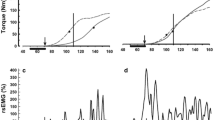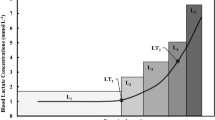Abstract.
In recent years, it has been recognised that improvements to classic models of muscle mechanical behaviour are often necessary for properly modelling co-ordinated multi-joint actions. In this respect, the purpose of the present study was to improve on modelling stretch-induced force enhancement and shortening-induced force depression of muscle contraction. For this purpose, two models were used: a modified Hill model and a model based loosely on mechano-chemistry of the cross-bridge cycle (exponential decay model). The models were compared with a classic Hill model and experimental data. Parameter values were based, as much as possible, on experimental findings in the literature, and tested with new experiments on the gastrocnemius of the rat. Both models describe many features of slow-ramp movements well during short contractions (300–500 ms), but long-duration behaviour is described only partly. The exponential decay model does not incorporate a force–velocity curve. Therefore, its good performance indicates that the status of the classic force–velocity characteristic may have to be reconsidered. Like movement-induced force depression and enhancement, it seems a particular manifestation of time-dependent force behaviour of muscle, rather than a fundamental property of muscle (like the length–tension curve). It is argued that a combination of the exponential decay model (or other models based on the mechano-chemistry of contraction) and structurally based models may be fruitful in explaining this time-dependent contraction behaviour. Furthermore, not in the least because of its relative simplicity, the exponential decay model may prove more suitable for modelling multi-joint movements than the Hill model.
Similar content being viewed by others
Author information
Authors and Affiliations
Additional information
Received: 19 March 1999 / Accepted in revised form: 9 June 2000
Rights and permissions
About this article
Cite this article
Ettema, G., Meijer, K. Muscle contraction history: modified Hill versus an exponential decay model. Biol Cybern 83, 491–500 (2000). https://doi.org/10.1007/s004220000190
Issue Date:
DOI: https://doi.org/10.1007/s004220000190




